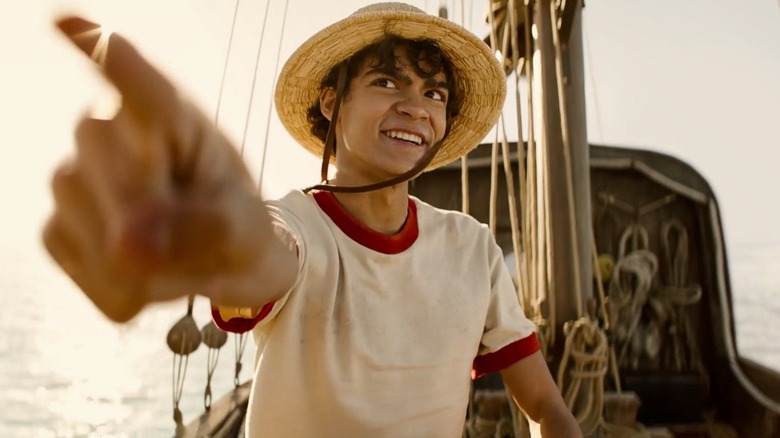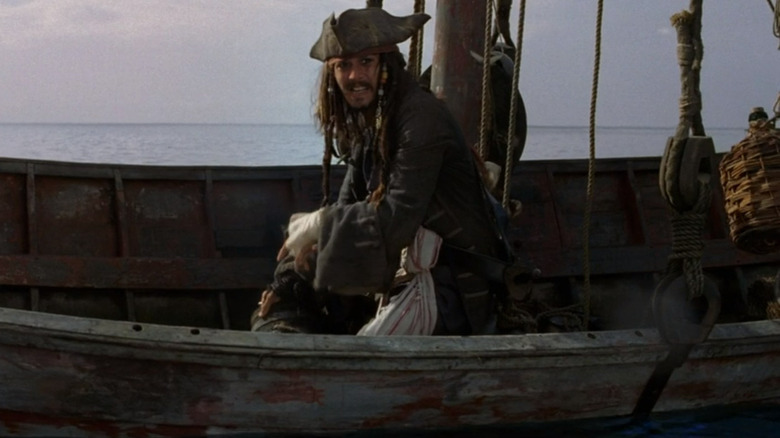Netflix's One Piece: This Episode 1 Scene Pays Homage To A Famous Movie Pirate
Contains spoilers for "One Piece" Season 1, Episode 1 — "Romance Dawn"
Monkey D. Luffy (Iñaki Godoy) is a legendary pirate who needs no introduction ... well, almost. "One Piece," Eiichiro Oda's classic manga series that stars the would-be king of the pirates, has been sailing strong since 1997, and its ongoing anime adaptation, which boasts a similar chronological tenure, is broadly considered one of the best animes of all time. But neither of these truths guarantees that audiences of Netflix's live-action adaptation will inherently know what's going on. And maybe that's why "One Piece" Season 1, Episode 1, "Romance Dawn," introduces its version of the captain of the Straw Hat Pirates with an homage to Disney's "Pirates of the Caribbean."
In his first scene, just after the contextualizing prologue, Luffy pilots a small vessel that's taking on water faster than he can bail it out. He rides his sinking boat directly into trouble that's thinly disguised as a sanctuary. Throughout the entire fiasco, Luffy behaves as though everything's fine, like sinking his only ship was his plan all along. If that sequence of events feels familiar, then you're someone who's watched "Pirates of the Caribbean: The Curse of the Black Pearl."
Disney's flagship pirate film introduces its legendary captain, Jack Sparrow (Johnny Depp), by sinking his one-man vessel just after the contextualizing prologue. And like Luffy, Jack escapes his potentially grizzly fate with a combination of style and luck.
Captain Jack Sparrow made modern audiences love pirates again
There's no interview with Netflix confirming a link between its adaptation of "One Piece" and Disney's "Pirates of the Caribbean" franchise, and there's no special thanks in the credits either, so any noted similarities are purely speculative in nature. But it makes sense. "One Piece" is this massive, beloved thing, but "Pirates of the Caribbean" changed action movies and saved the pirate genre. Without Jack and his cohorts, the modern pirate media era, including Max's "Our Flag Means Death," might not exist. Consider what piratical adventures were available shortly before "The Curse of the Black Pearl" — it's difficult to name anything that isn't an adaptation of "Treasure Island" or "Peter Pan."
Disney showed modern audiences that pirates could be more than simple swashbucklers by putting a quirky character in the forefront — because Jack isn't so much a good pirate as he is a good pirate to watch. He's quick-witted and hilariously inept, and it isn't really hard to understand why Netflix might want its audiences to compare its star to the guy who defined the genre.
Like Jack, Luffy is a bad pirate. Yes, he wants to find hidden treasure, but he also wants to save innocent civilians from dangerous marauders. He wants to make sure his friends feel loved and supported. More than anything, he just wants to eat good food. By using famous imagery from a beloved modern pirate media franchise, Netflix guarantees that a wider swath of its audience immediately knows what Luffy is about, even if they don't immediately understand why he's super stretchy and fears saltwater.

